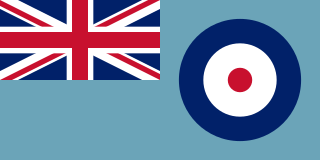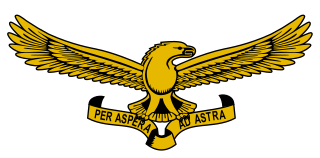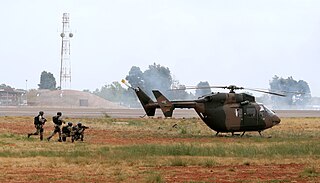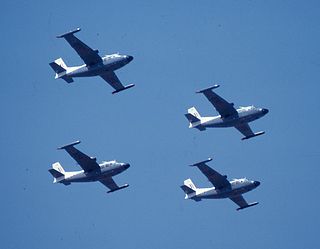| 50 Squadron | |
|---|---|
 Junkers F13, similar to those operated by 50 Squadron | |
| Active | 1939-c. 1946 |
| Country | |
| Branch | South African Air Force |
50 Squadron SAAF was a South African Air Force squadron during World War II.
| 50 Squadron | |
|---|---|
 Junkers F13, similar to those operated by 50 Squadron | |
| Active | 1939-c. 1946 |
| Country | |
| Branch | South African Air Force |
50 Squadron SAAF was a South African Air Force squadron during World War II.
50 Squadron was formed on 1 December 1939 by amalgamating the SAAF's 17, 18 and 19 Squadrons. [1] During the East African Campaign 50 Squadron operated a 'shuttle service' between the warzone in East Africa and South Africa as part of 1 Bomber Transport Brigade. The brigade was re-designated 5 Wing in February 1941, and continued to fly 'shuttle service' flights between the Mediterranean and South Africa until after the war. [2]
The squadron operated Junkers F.13FE, Ju-86Z/K-1 and Ju 52/3M aircraft which had been requisitioned from the South African Airways at the outbreak of war. The eleven Ju 52's were assigned to 51 Flight, operating a shuttle service from Nairobi to Egypt, Middle East and South Africa.

The Desert Air Force (DAF), also known chronologically as Air Headquarters Western Desert, Air Headquarters Libya, the Western Desert Air Force, and the First Tactical Air Force (1TAF), was an Allied tactical air force created from No. 204 Group RAF under RAF Middle East Command in North Africa in 1941 to provide close air support to the British Eighth Army against Axis forces. Throughout the Second World War, the DAF was made up of squadrons from the Royal Air Force (RAF), the South African Air Force (SAAF), the Royal Australian Air Force (RAAF), the United States Army Air Forces (USAAF) and other Allied air forces.

The Junkers Ju 52/3m is a transport aircraft that was designed and manufactured by German aviation company Junkers. It was developed in the late 1920s, first flying in 1930 as a civilian airliner. The Nazi regime in Germany at the time took over the company, and heavily produced the design for its war efforts over the objections of Hugo Junkers.

The South African Air Force (SAAF) is the air warfare branch of South African National Defence Force, with its headquarters in Pretoria. The South African Air Force was established on 1 February 1920. The Air Force saw service in World War II and the Korean War. From 1966, the SAAF was involved in providing infantry support in the low-intensity Border War in Angola, South-West Africa and Rhodesia. As the war progressed, the intensity of air operations increased, until in the late 1980s when the SAAF were compelled to fly fighter missions against Angolan aircraft in order to maintain tactical air superiority. On conclusion of the Border War in 1990, aircraft numbers were severely reduced due to economic pressures as well as the cessation of hostilities with neighbouring states.

The Junkers Ju 86 was a German monoplane bomber and civilian airliner designed in the early 1930s, and employed by various air forces on both sides during World War II. The civilian model Ju 86B could carry ten passengers. Two were delivered to Swissair and five to Deutsche Luft Hansa. In addition a single civilian Ju 86Z was delivered to Sweden's AB Aerotransport.

2 Squadron is a squadron in the South African Air Force which was formed in 1940. The squadron has a long history, having been involved in every single combat action in which the SAAF has taken part. During the Second World War it made a name for itself in the battles for East Africa, before distinguishing itself in North Africa as part of the Desert Air Force, and later in Italy.

17 Squadron SAAF is a squadron of the South African Air Force. It is currently a transport/utility helicopter squadron.

15 Squadron SAAF is a squadron of the South African Air Force. It is currently a transport/utility helicopter squadron.

19 Squadron SAAF is a current squadron of the South African Air Force operating as a transport/utility helicopter squadron. It was formed in 1939 as part of the Air Force airways Wing, flying transport aircraft but was disbanded after a few months. It was re-formed from No. 227 Squadron RAF in 1944 and disbanded again after the end of World War II. It was again re-established in 1970 as a helicopter squadron – a role which it still performs today.

22 Squadron is a squadron of the South African Air Force. It is currently a maritime helicopter squadron operating Lynx and Oryx helicopters for the South African Navy. Originally formed in 1942, the squadron is the only current maritime helicopter squadron of the SAAF. It has been involved with many rescues, some gaining international attention as well as arctic base support.

1 Squadron SAAF was an air force squadron of the South African Air Force and was formed at Air Force Station Swartkop in February 1920, equipped with De Havilland DH.9's part of the Imperial Gift donation to South Africa by Britain. On 31 August 1939 the squadron was re-designated as 1 Bomber/Fighter Squadron and this was then changed to 11 (Bomber) Squadron in December 1939. The squadron was resurrected in February 1940 by the renumbering of 6 Squadron, equipped with four Hurricane Mk 1's and six Furies.
Air Headquarters East Africa was a command of the British Royal Air Force (RAF) formed on 19 October 1940 by expanding AHQ RAF Nairobi. On 15 December 1941, the command was reduced to Group status as No. 207 Group. On 16 November 1942, Air H.Q. East Africa was reformed by raising No. 207 Group back to Command status again.

John Albert Axel Gibson, was a Royal Air Force (RAF) officer and a flying ace of the Second World War. He was credited with the destruction of 12 enemy aircraft.

12 Squadron was a South African Air Force squadron that served in the Second World War in East Africa and the Western Desert as a medium bomber squadron. After the war, the squadron was used in various roles, including that of a helicopter squadron until 1963, when it was equipped with English Electric Canberra light bombers, remaining a light bomber and reconnaissance squadron until disbanded in 1990.

27 Squadron was established as a World War II maritime patrol squadron of the South African Air Force. It was disbanded after the war and resurrected in the same role from 1951 to 1958. Its final period of service was from 1962 to 1990 when it was finally disbanded when its Piaggio Albatross aircraft were de-commissioned.

31 Squadron was initially a World War II Coastal bomber/reconnaissance squadron South African Air Force. It was later converted to a heavy bomber squadron that operated from bases in the Mediterranean from January 1944 until the end of the war. On conclusion of hostilities, the squadron was used to ferry liberated POW's from Italy back to Britain and disbanded South African troops from Italy to Egypt. It was disbanded on 15 December 1945. It was resurrected as a medium and light helicopter squadron in 1982 and operated from AFB Hoedspruit until its final disbandment on 4 December 1992.

The Imperial Gift was the donation of aircraft from surplus stocks in Britain after World War I to the dominions of the British Empire: Canada, Australia, New Zealand, South Africa and India. On 29 May 1919, the Cabinet of the United Kingdom agreed to give 100 aircraft to the dominions in addition to replacements for aircraft donated to Britain during the war. These aircraft formed the core of newly established air forces in several dominions.
The History of the South African Air Force spans the First World War, Rand Rebellion of 1922, the Second World War, the Korean War, the South African Border War, and varied peacekeeping operations since 1994. Its battle honours include German South West Africa 1914–15, German East Africa 1915–1918, East Africa: 1939–1941, Middle East: 1941–43, Madagascar 1942, Italy 1943–1945, the Balkans 1943–1945, and Korea 1950–1953.

42 Squadron SAAF is a disbanded squadron of the South African Air Force, active from 1945 to 2000. The squadron's main role was to spot enemy artillery. The unit was formed in 1945 as 42 AOP Flight, flying Austers under command of an officer of the SA Artillery and was the only army aviation unit flying for South African forces during World War II.

16 Squadron SAAF is an attack helicopter squadron of the South African Air Force (SAAF). It was originally formed in World War II as a maritime patrol squadron, however, over the course of the war it was disbanded and reformed a number of times, operating a number of different types of aircraft. It was finally disbanded in June 1945 and was not re-raised until 1968 as a helicopter squadron. In the late 1980s the squadron took part in the conflict in Angola before being disbanded again in 1990. It was raised once more in 1999 and it is currently operating the Rooivalk attack helicopter.